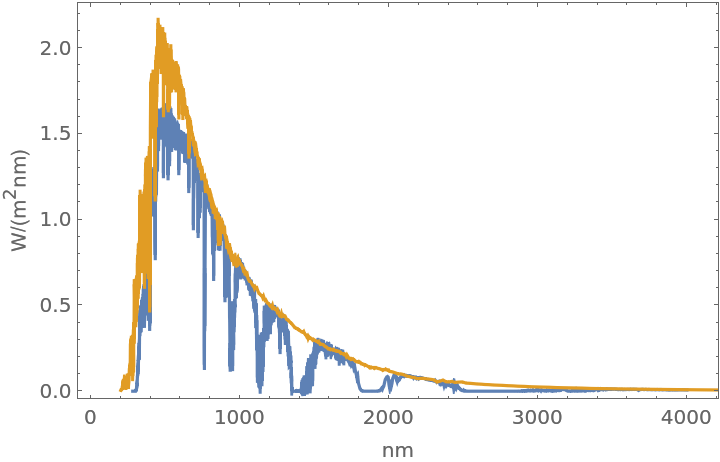Wolfram Function Repository
Instant-use add-on functions for the Wolfram Language
Function Repository Resource:
Obtain wavelength-dependent solar irradiance data for the Earth
ResourceFunction["SolarIrradianceData"][type,λ] gives solar irradiance data of the type type for wavelength λ. | |
ResourceFunction["SolarIrradianceData"][type,f] gives solar irradiance data for frequency f. | |
ResourceFunction["SolarIrradianceData"][type,{λ1,λ2}] gives the total solar irradiance within a wavelength range from λ1 to λ2. | |
ResourceFunction["SolarIrradianceData"][type,{f1,f2}] gives the total solar irradiance within a frequency range from f1 to f2. | |
ResourceFunction["SolarIrradianceData"][type,format] gives full solar irradiance data in the specified format. |
| "ExtraterrestrialIrradiance" | solar irradiance incident on the Earth's atmosphere |
| "SurfaceIrradiance" | solar irradiance incident on the Earth's surface |
Calculate the solar irradiance of 500 nanometers light on the Earth's surface:
| In[1]:= |
| Out[1]= |
Determine the solar irradiance of 500 THz light on the uppermost reaches of the Earth's atmosphere:
| In[2]:= |
| Out[2]= |
Compute the solar irradiance for green light on the earth's surface:
| In[3]:= |
| Out[3]= |
| In[4]:= |
| Out[4]= |
Specify frequencies to integrate solar irradiance over:
| In[5]:= |
| Out[5]= |
Obtain all the data for surface solar irradiance:
| In[6]:= |
| Out[6]= |  |
Find the wavelength in the data set with the maximum solar irradiance:
| In[7]:= |
| Out[7]= |
Retrieve an interpolating function for solar irradiance outside the atmosphere:
| In[8]:= |
| Out[8]= |
| In[9]:= |
| Out[9]= |
Compare solar irradiance above and below the atmosphere:
| In[10]:= | ![ListLinePlot[{ResourceFunction["SolarIrradianceData"][
"SurfaceIrradiance", "Data"], ResourceFunction["SolarIrradianceData"][
"ExtraterrestrialIrradiance", "Data"]}, Frame -> True, FrameLabel -> Automatic]](https://www.wolframcloud.com/obj/resourcesystem/images/f57/f57ccedd-bffd-4a08-b142-4368eff8d7f8/743dc33baca98e56.png) |
| Out[10]= |  |
Compare the peak wavelength in the data set for extraterrestrial irradiance to that predicted for a blackbody:
| In[11]:= |
| Out[12]= |
| In[13]:= |
| Out[13]= |
This work is licensed under a Creative Commons Attribution 4.0 International License